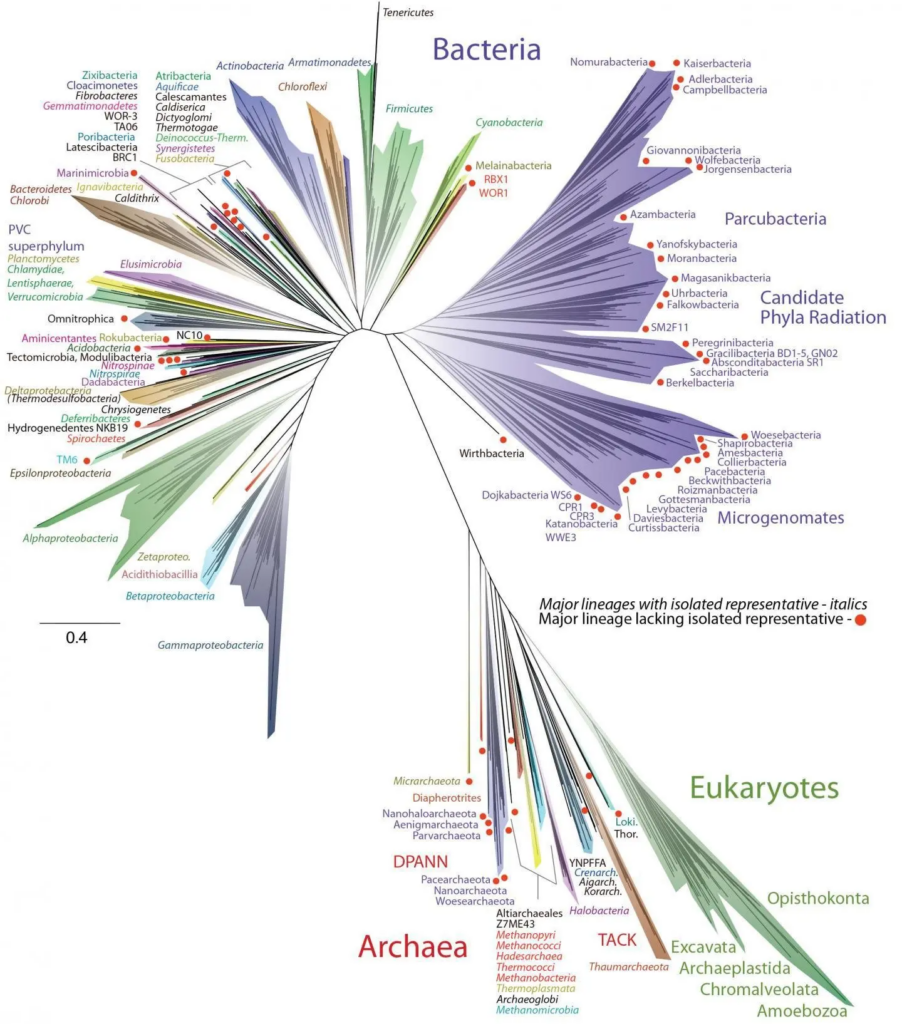Or, Shadow Puppetry and Meat
Prologue: This is not a place of honour
I want you to treat what I am going to say next like I’m a creepy old man at a gas station in a horror movie: Turn back, this is your last exit before we get weird. I am not a fan of James Cameron’s Avatar. I am not a fan of any of James Cameron’s films. I might be one of the few people on earth who thinks that Aliens isn’t just a bad film, but a cruel mockery of everything that made Alien good. I don’t think I’m a James Cameron hater. I don’t really care enough about him as a creator to do that. The majority of interesting things I could say about these films has already been said, by people far more articulate than me. I don’t think this piece is going to contribute to any productive conversation. I don’t think you will find anything pure and good deeper in this article. I have warned you. Now hop in loser, we’re going to the movies.
Chapter 1: Movies from 2009: subtitles galore
I was ten when I first saw Avatar. There was a cinema by my parent’s work, and when I got bored of pacing around their office, they would give me $20 to go see a movie. I would be alone, or with one of my siblings, and I’d watch whatever was on that day. Often the decision of what to watch wasn’t made by us, but by the whims of the cinema schedule. We’d watch whatever we could be let into, and whatever was playing next. It wasn’t about quality, we didn’t develop some cinephile eye that reacted with thoughtful critique. To give you a sense of my filmgoing experience, I saw the following movies when I was ten years old: Kung Fu Panda, The Incredible Hulk, Get Smart, The Love Guru, Hellboy II: The Golden Army, Journey to the Centre of the Earth, Beverly Hills Chihuahua, City of Ember, The Boy in Striped Pajamas, Bolt, The Day the Earth Stood Still, The Princess and the Frog, The Tale of Despereaux, Yes Man, Bedtime Stories, Hotel For Dogs, Inkheart, Monsters vs Aliens, Dragon Ball Evolution, X-Men Origins: Wolverine, Land of the Lost, G-Force, Aliens in the Attic, G.I Joe: Rise of the Cobra, The Invention of Lying, Astro Boy, Cirque Du Freak: The Vampire’s Assistant, Planet 51, Transformers: Revenge of the Fallen, 2012, and Avatar.
Avatar was not the best of these films (Kung Fu Panda), it’s not even the best film about aliens I saw that year (District 9, which I didn’t see in cinema, but in a tent in the Coromandel that same summer). Avatar was, however, without a doubt, the longest film I had seen at the age of ten. I was in that cinema next to my parents’ work for so long that my mother had started to worry that I had been kidnapped. I came out of the cinema at around 5:30 in the evening, my mum had finished work. She was not happy about the length of Avatar. I remember sitting across from her and my sister in a little booth in a little café, while my mum told me that both she and my sister had been waiting for the past half an hour for me to leave the cinema. I remember my sister asked me what the movie was about. It wasn’t a question about the quality, or the content of the film. She wanted to know how a movie could be that long. What could it possibly be about? What could possibly happen in a movie, that it needed almost three hours to come to a conclusion? She wasn’t asking what Avatar was about, she was asking what cinema was about. What was the point of witnessing something in a dark room for three hours, preshow advertisements included?
I don’t really remember what I said to her in response. I remember saying something about blue aliens, and robots. I remember explaining that it wasn’t in any way related to our favourite TV show. I hope now, armed with the ordnance of time, I can answer her question.
I haven’t treated this task lightly. I have delved deep into the Avatar lore, I read the tie-in art books, I looked through Weta Workshop concept art, I read academic essays on these films, I went deep into our world’s biology, I watched virtual tours of the Avatar: Flight of Passage attraction, I learnt things no one should know about Na’vi genitalia. I still don’t have a good answer for my sister.
These movies don’t really have coherent themes throughout. They absolutely have an ideology, and that’s something I’ll save for later, but to start, I want to approach these films where they are strongest. The thing that stuns us in the cinema, and what we remember when we’re scolded by our parents in a little café. The visual verisimilitude of these films. This is not James Cameron’s first attempt at making a film about an alien ecology. It’s not even his second. Both the Abyss, and Aliens, give us some of the outlines of an alien biosphere. However, both these films are centred on us identifying with the humans who encounter these uncanny creatures. Not only does Avatar put us on the same side as the Na’vi, it depicts their bodies and their environment with as much detail as it can. That seems to be the goal these films hold above all else. Sure, they have themes, characters, plots, speculations, but these movies are about one thing at their heart: making freaks that are so vivid, you feel as though there must be veins beneath that blue skin.
Let’s break down the biology of Pandora, and pry apart whatever lies within. Follow me down this rabbit hole. Watch as I peel away the layers of smooth Smurf-flesh in search of a taxonomy. Look at how I crack open the ribcage, and remove the 900-gram Na’vi heart. See it balance on the scales, find out if it is heavier than a feather. I will project it onto a platter for you. You can decide if it is impure, and whether or not it should be fed to the crocodiles.
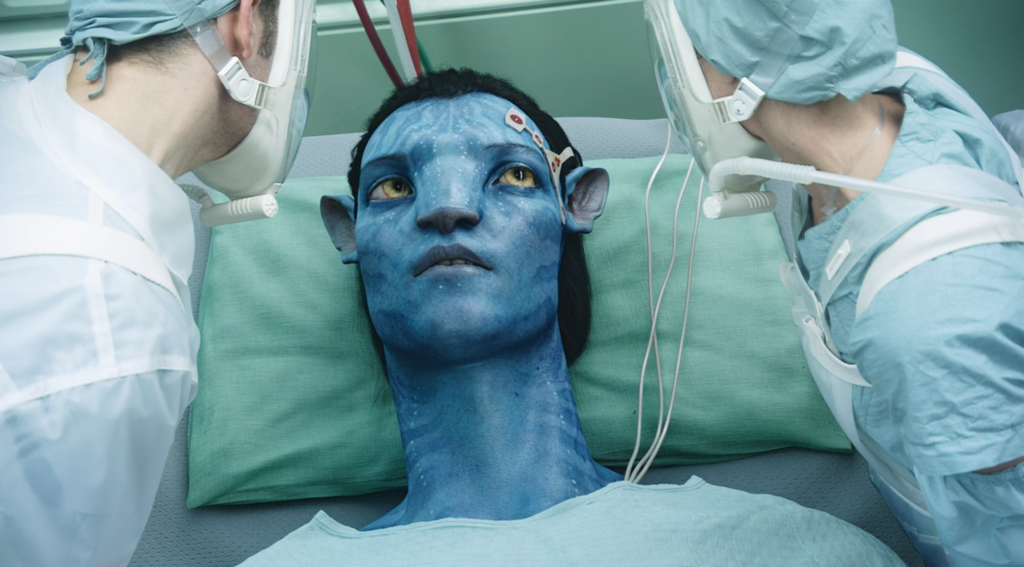
Chapter 2: Fictional biologists hate her! This one plant figured out one quick trick to achieve panspermia!
I am not a biologist. I’m barely a hobbyist. Beyond getting merit endorsement in NCEA Level 2, I am not formally or institutionally trained in any fields related to biology. That said, neither is James Cameron (I’m at least 75% sure he does not have a NCEA Level 2 merit endorsement in biology).
When it comes to the plausibility of Pandora, I am not going to point at things that stretch the bounds of biology and laugh. That’s not a useful mode of analysis, and everyone hates that guy. Instead, I’m going to treat everything we see in these films as if it is true, and then work backwards to find out why. For example, plenty of life on Pandora resembles life on Earth, even the Na’vi are somewhat analogous to us in their physiology. Some of the stuff within Avatar’s lore that I think is genuinely cool, is how it works around this issue. One of the most interesting little details relates to the fact that Pandora is full of cycads that are almost identical to those occurring on a prehistoric earth. The only rational explanation for this is that somehow Earth was pollinated by Pandora, an event so improbable, that collectively Earth’s biologists have decided to throw their hands into the air and give up on trying to solve it. It’s a neat little detail in the margins of this world, and one I think works entirely because it will never be answered, and because of all that it implies. (Sidenote, I hope this detail never gets elaborated on. I do not want James Cameron to make his version of Prometheus.)
The other part of Avatar’s worldbuilding that needs a little more work to justify, is Eywa. It’s pretty clearly established throughout both films, that the majority of life (as far as we can tell, everything except for the microbial life) is connected through Eywa. Eywa is Pandora’s Gaia-like figure, and is universally worshipped across the planet. Which… Sure. Let’s couch that for now.
Eywa is partially personified by the planet-spanning network of roots that run through Pandora like mouldy bread. This root network and the connections that the creatures of Pandora have with this network are all a part of Eywa. In terms of biological justifications, this is where the film deals more in metaphor than materialism. Most life on Pandora can literally plug into this network, allowing the Na’vi to store their memories, exchange information, and bond with animals. It’s established several times within the lore that Pandora has its own unique group of organisms, known as zooplantae, which are plants with simplified nervous systems. Even nature has a brain. The various complex relationships Indigenous people have with their environment are replaced by a physical bond. A biological metaphor that shows how all life is connected.
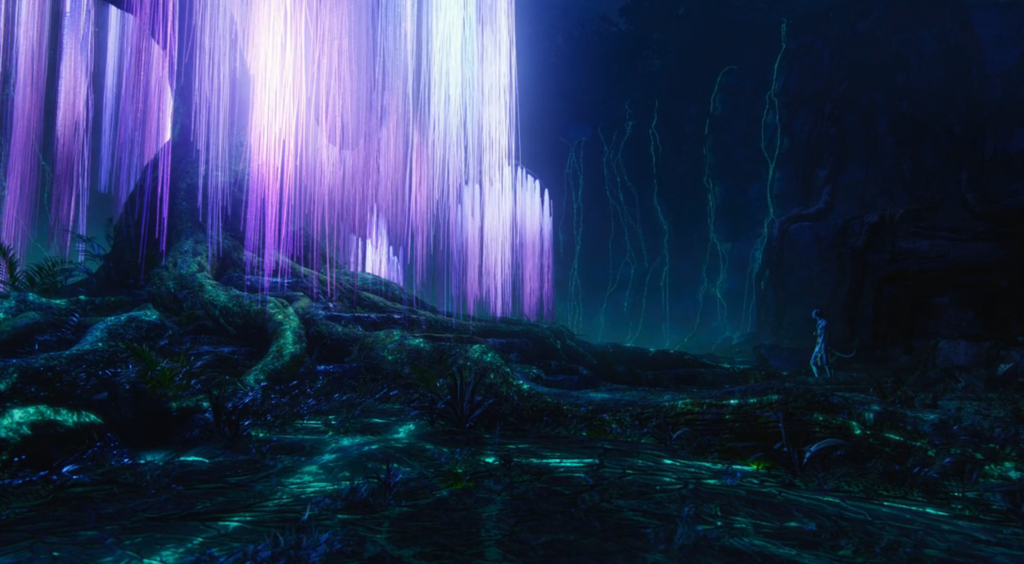
There are real-world organisms somewhat analogous to Eywa’s network. As several articles and annoying trivia nerds will point out, our planet is home to a bunch of vast and complex root networks. The most well-known of these networks is the Humongous Fungus, a several-kilometre-wide honey fungus in the Pacific Northwest.
Which is exactly the kind of scientific basis that sci-fi blockbusters love to work with. It’s vaguely correct and provides enough of an excuse for the flashy spectacle the general audience craves. The point isn’t scientific accuracy (that’s not the point of this article either), but to create enough grounding for the audience to accept the reality they’re being shown. What I’m interested in, is all that these hand-wavy analogies cover up.
The enormous honey fungus in the Pacific Northwest is not a benevolent representation of life as Avatar suggests. Unlike Eywa, honey fungus is not a benevolent giver. In fact, it eats away at the conifers that surround it. The Humongous Fungus can only grow so large because most of its competition is dead, or currently feeding it. Not only is it the world’s largest organism, it’s also the world’s largest parasite. It’s impressive, and detrimental to most of its environment.
But maybe Pandora is different. Eywa isn’t just one species of fungus, but a vastly diverse network of organisms that share a common network. From what we know, Eywa is integral to the life of Pandora. The ecological balance of these organisms is maintained by that connection to Eywa. Every animal we see on Pandora is able to plug into the information highway of Eywa. While it’s possible that you could have a large fungal network, as we’ve seen on Earth, what’s a little harder to find some biological reality for, is the universal USB ports of every species.
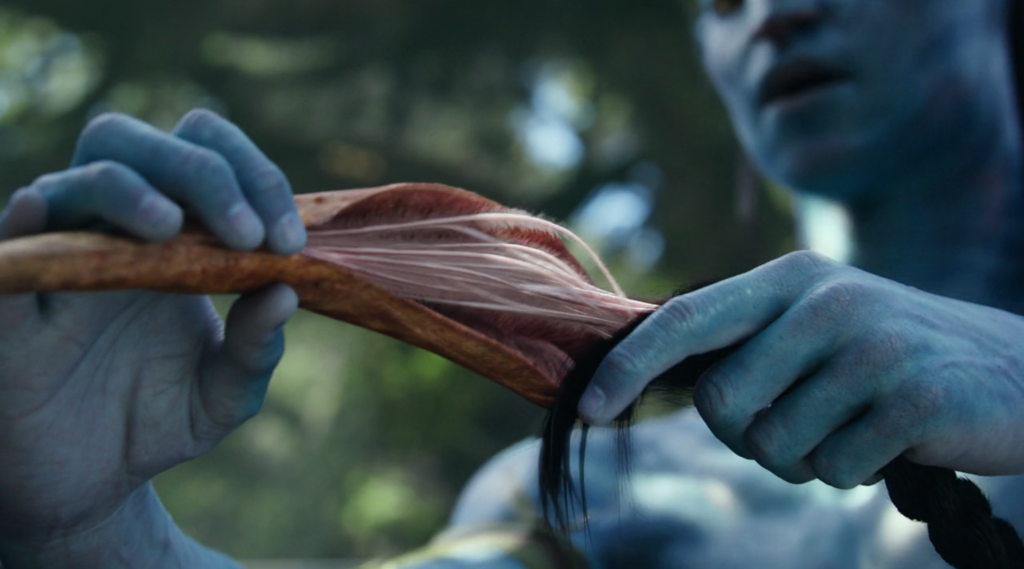
In the world of Pandora, these are known as ‘queues’ (and they are NOT genitals! That is a common misconception. The queues are involved in sex, but more as an erogenous zone). While most of Pandora’s megafauna have these queues prominently displayed, even species without an obvious queue can still connect. The gill mantles in the second film, which lack a dangling queue, are still able to attach to the Na’vi and share a respiratory bond (This is important. Take note of this, you’ll feel really smart later on).

Chapter 3: Nature is not a prudent gardener
Evolution is not picky, it is utilitarian. Despite what the X-Men will have you believe, life does not ‘progress’. Organisms do not get ‘better’ as evolution happens. Every stage in evolution is a response to the environment at the time. If a species finds its niche, and isn’t threatened, then it will stay there indefinitely. A great example of this are sharks, and horseshoe crabs, both of which found their niche around the same time that Saturn’s rings were forming, and decided to stick with it. For life to change, there needs to be some kind of pressure within an environment. (I know biologists are yelling out ‘genetic drift!’ right now, please be quiet). Even if there’s something detrimental to an organism, it won’t change unless it is a threat to the continued existence of the entire species. Despite us not needing our appendix, and the discomfort it can cause, it’s not going to go anywhere. Just as there’s no need for an appendix, there’s also no need to get rid of it. So, it just sits in your gut, bored and vestigial.
All life on Pandora can connect to Eywa. Even the creatures that lack a central nervous system still have a neural queue. This means that for everything on Pandora, there either needs to be an environmental pressure causing them to develop the neural queue, or a lack of pressure that causes them to retain it. Either not being able to connect to Eywa is a death sentence for your species, or all life on Pandora is descended from a single common ancestor who had this queue.
The first option is something called convergent evolution, where unrelated species will end up evolving similar traits. Bats and birds are very distinct species, but they do share wings. Famously, there is an evolutionary trend in which disparate species slowly turn into crabs, known as carcinization. So, in the first scenario, all life on Pandora slowly diverged from a common ancestor, just like Earth, different species and mutations found their niche. Then, something happened, and connecting to Eywa became a biological necessity. Everything slowly evolved to have some physical means of linking up with this enormous tree network. Life diverged into different species, and then they all needed to develop a neural link in order to prevent extinction.
The second option might look pretty similar to the first. The difference is that the development of the neural link happened early on in the evolutionary process. The neural link came first, and then life diverged into different species. All this while, the neural link needed to remain if not useful, at least not harmful enough that species would maintain the traits necessary. Like a vestigial tail. This early form of life wouldn’t have to be the first organism on Pandora, but it would need to be the ancestor of every species on the planet. Whatever other forms of life might have existed on Pandora, they have died out long before Cameron’s cameras arrived on set. The neural queue might have not even been necessary for survival, it might have just been random chance that the neural queue organism was the one who made it through time. This sounds farfetched, but that’s exactly what happened on Earth.
Chapter 4: Started from the bottom (of an anaerobic hydrothermal vent), now we’re here
All life on Earth comes from something called the Last Universal Common Ancestor (LUCA). From what we can tell, LUCA was not the first living thing on Earth. LUCA probably lived in deep sea vents, and it was not alone. It, and its neighbours, might have been millions or billions of years in the process of dead stone twitching to existence. However, none of its neighbours survived. From what we can tell, LUCA was not unique in anyway, there were probably billions of organisms just like it. LUCA had no special advantages, it didn’t outcompete its ancestors, or drive them to extinction. The only thing that’s special about LUCA, is that they survived long enough. Long enough to grow and develop and spread out into every possible niche. Long enough for lightning to push through thick liquid chemistry, producing thought like a circuit giving off waste heat. Long enough for that radiation of consciousness to shape itself into patterns, and for those patterns to exist somewhere in the space between meat. Long enough for those patterns to become language, and with that language let those cell clusters collaborate and come to some conclusions of awareness. Long enough for the cells that once were LUCA to look back and see themselves staring back across history, a mirror of time. Wave and say hello.
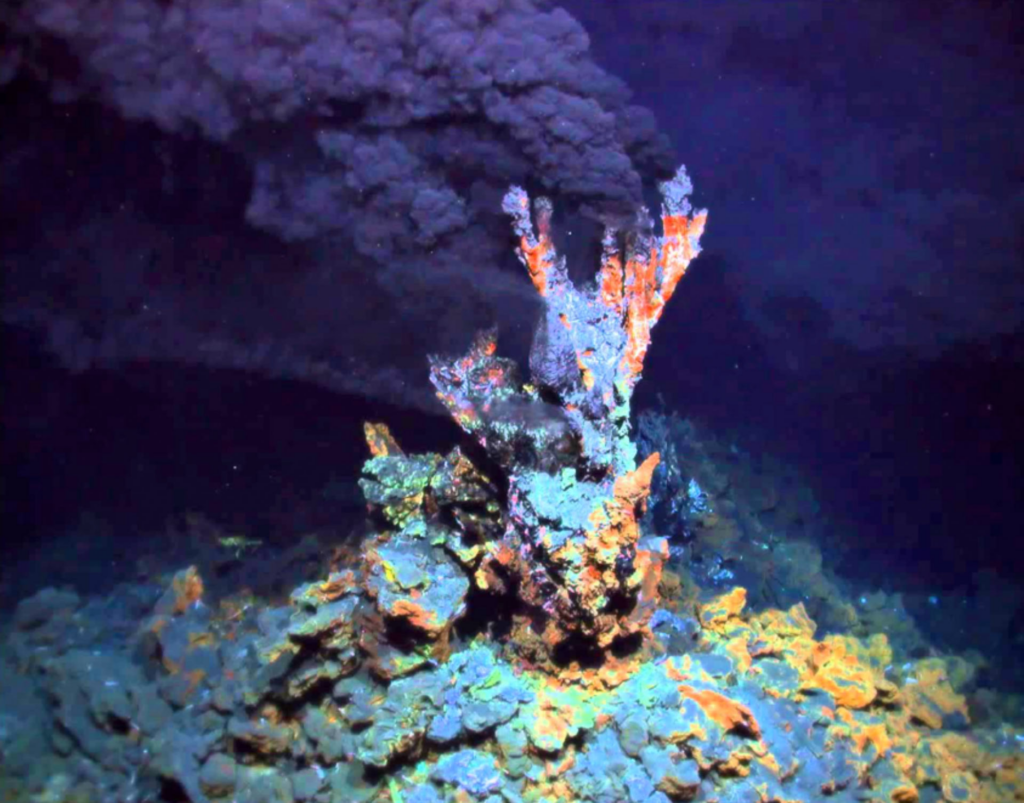
So, that could be the answer, the neural queue is a holdover from Pandora’s protozoan age. Just like the 30 genes that all life on earth share. Though, I have to throw some doubt into this one. Given the complexity of the neural queue, and its existence even with organisms without a central nervous system, it doesn’t make sense for these organs to just be vestigial. While everything on earth shares some genetic code, what we don’t share is a universal physiology. There are no physical traits that exist across all walks of life, except for the most basic functions required to be defined as ‘alive’. This means that the neural queue needs to be part of the basic function of life. Most likely, calling it a ‘neural’ queue is actually a misnomer, as it probably does a lot more than just connect different nervous systems.
Throughout the films, we learn a little about Pandora’s atmosphere. While Pandora has a breathable percentage of oxygen in its atmosphere, it also has an extremely high concentration of carbon, which makes the atmosphere unbreathable for humans. We learn in the second film, that the Na’vi can survive in an Earth-like atmosphere for hours, while we can barely stand a few seconds on Pandora. This is because the Na’vi have a specialised organ called a wichow, which works to process the oxygen and carbon more effectively. Why do the Na’vi have this organ? Well, it turns out, they’re not as good at breathing as us.
Chapter 5: In which I reference Peter Watt’s Blindsight, and Hannah Montana.
Early on in Earth’s evolution, a few million years after LUCA, a weird thing happened. A bacteria consumed another organism, but instead of eating it, it assimilated it into the body. This meal was the mitochondria, the powerhouse of the cell. The mitochondria allowed us to perform aerobic respiration. Thanks to the mitochondria, we could take in oxygen and use it to produce something called adenosine triphosphate (or ATP). In extremely simple, and reductive terms, ATP is what you need for life to happen. It’s the energy that powers everything that lives. Before the mitochondria, we were stuck with anaerobic respiration, which produced far less ATP, but got the job done. Now, like Hannah Montana, we get the best of both worlds. Most of the time we’re using aerobic respiration, or ‘Miley Cyrus Mode’, we can chill out, take it slow. However, when we need to rock out the show, or haul ass away from a sabretooth tiger, we rely on anaerobic respiration. Since this method gives us a sudden and rapid burst of ATP.
Imagine you are the last common ancestor of Pandora. You’re not the first life to develop, but you’re the only one who will survive long enough. Maybe you’ve just managed to string together a couple of cells. What you haven’t managed to do, is get a proper mitochondrion going. Maybe you have a shabby imitation of the mitochondria, which can perform aerobic respiration, but not to the same extent as any life on Earth. Normally, this would be a problem, but due to the density of oxygen and carbon within your atmosphere, you can make up for this shortfall in ATP production. Because of the difficulties of respiration on Pandora, life diverges into two groups, each specialising in a different method of ATP production.
The first group is your stationary class. These guys specialise in anaerobic respiration. They produce far less ATP than their counterparts, and it takes a lot longer for them to do so. Since they’re stuck with anaerobic respiration, these guys have to spend long periods of time in a dormant, stationary state. Due to the nature of anaerobic energy, they can have sudden bursts of movement, but doing so costs them a few hundred years of rest.
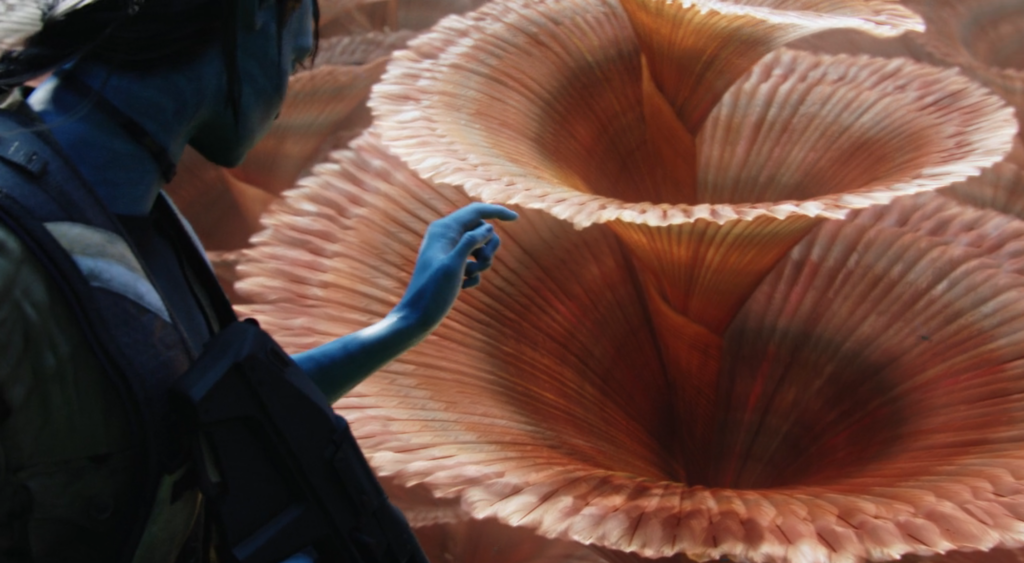
The second group are your roaming class. These guys have specialised in aerobic respiration. They use their knock-off mitochondria to produce a lot more ATP than their counterparts, but they’re not great. Despite the fact that they have to move around, their energy requirements aren’t great for it. Unlike humans, these guys aren’t capable of sprinting. They can’t burn glucose stored in their body for sudden bursts of speed like their stationary neighbours.
To help compensate for their shortcomings, both these groups begin working together. The stationary group provides the roaming group with a whole bunch of fast-burning, high-release energy. In return, the roaming group gives them a taste of what that sweet aerobic respiration can do. They use each other to reap the benefits of both forms of respiration. The roaming group get a huge benefit from this, if they charge up using a stationary organism, they get a nice store of energy they can burn in case of an emergency. Meanwhile, the stationary group can fuel up using the roamers like a temporary mitochondrion.
Keep in mind, that we’re still very early in Pandora’s evolutionary process. It’s likely that the organisms we’re talking about here are microscopic, or near microscopic. Eventually, however, your roamers start getting a little more complicated. See, they’ve started experimenting with this neat little thing called a central nervous system. Unfortunately, it requires quite a lot of energy to power it, more than what they can normally achieve with just their aerobic respiration. So, your roamers come up with a pretty simple solution. They just feed all the energy from their stationary friends straight into it. While it usually isn’t a good idea to have an exposed nervous system, it’s slightly better than having no nervous system at all. The ‘neural’ queue doesn’t start with the brain, but as a proboscis lung. This is why some organisms that lack a central nervous system are still able to be linked with. (The people who remembered the gill mantle can feel clever now). Everything on Pandora is sharing its breath with each other. Over a few million years, the exact nature of what these species can transfer gets a little more complicated. Some of your roaming species take up a stationary lifestyle, giving rise to the zooplantae. Your roamers develop specialised organs to aid in the distribution of oxygen around the body. Like I said before, nature doesn’t develop anything unless there’s a pressure to do so. Because of the need to be efficient at separating oxygen and carbon, the roamers slowly adapt by having a wichow. Put this all in the oven for a few billion years, bake on high, and you end up with Pandora.

Chapter 6: Caves walls, hard and soft bodies, despair.
I cannot tell you how excited I was when I came up with this justification. I had spent days trying to figure some kind of plausible evolutionary process out. I thought that would be the thing that somehow unlocked everything and helped me understand what is going on in these movies. If I could solve the biology of Avatar, maybe then I could break it down.
Except, it didn’t work. Because like I said at the start, James Cameron is not a biologist. He tells stories. Sure, I can come up with a hypothetical biology, but that doesn’t give us anything beyond an interesting detour. A brief time in the dark where you can look at this screen and admire some of the spectacle of life. But even my answers don’t hold up to much scrutiny. Anyone with any understanding of biology, or chemistry knows the flaws (the distances of neural transmission are far too great for that sort of chemical exchange. Simpler means of energy exchange exists, it’s called eating).
Life is messy, and complicated, and beyond any one person’s understanding. Sometimes its easier to just settle for spectacle. You can see where James Cameron does it. If you look closely, you can see the points where these films give up on trying to learn, or trying to teach. Instead, they show you some beautiful shapes in a dark room, and you go home.
The point of the neural queue on Avatar is not to invoke any ideas of chemical exchange, or for you to consider the hypothetical ways life could develop such a mechanism. You’re supposed to see it and go ‘oh, a metaphor for Indigenous relations to nature’. A metaphor, I might add, that comes from a Pākehā perspective of those relationships. Cameron makes the same mistake that pop-science icons like Richard Dawkins make about Indigenous knowledge. They assume that while Europe developed guns, germs, and steel, the rest of the planet was frozen in time. They assume that all of human culture exists on a video game tech tree, and Europe were the only ones that specced into ‘science’. The point of Avatar isn’t to sympathise with the Na’vi. The point is to see the Na’vi, and sympathise with the humans who lost all that the Na’vi have. Jake, on one knee as he speaks to Eywa says ‘the world we come from, there’s no green there. They killed their mother, and they’re gonna do the same here’. We are supposed to look at Pandora and see all that we have ‘lost’ on our planet.
Avatar does not explore a possible future for humanity, it explores an idealised past. Cameron is making films about a return to Rousseau’s idealised state of nature. A state that, within Cameron’s imagination, can maintain its technology and its perspectives, as long as they’re eco-friendly. Philosopher Timothy Morton, in his piece Pandora’s Box: Avatar, Ecology, Thought, states it better than I ever could, “the Na’vi are simply more successful at playing the game humans are playing. They are upgraded humans — or we are downgraded Na’vi. By wishing for and consuming the right things, we will create a just society; we just have to change our ways a bit. Isn’t this the dominant environmentalist paradigm of our age?”
When the Na’vi link to an animal, they are not sharing a bond. We don’t see any of their mounts making demands of their owners. No, they just give some resistance at first, and then they are broken. They are not animals, they are vehicles. The bond they make is the bond I share with my car and my keys. Once I know how to drive it, it does as I tell it to. The Na’vi are just as exploitative of their environment as humanity, except they are given a biological loophole. Their exploitation is good for the environment. They get to keep all the comforts we enjoy, just with a cool new flavour. Instead of ethernet cables they have tree roots. This goes down to the fundamental ideas of these films. The concept of the avatar, a body driven by a remote operator. The final conflicts of these films are between hard and soft bodies. The technological monstrosity against the idealised flesh. The Na’vi ride their banshees and their thanators, linked through the natural bond of Eywa. While humanity is strapped to steel corpses, moving their clunking mechanical bodies with brutal iron minds. The Na’vi succeed because their technology is better, purer. The coloniser fails to consider, it might be sick as fuck to drive a dragon.

Chapter 7: Remember to breathe.
The Na’vi do not learn to interact with nature, it is inherent to them. It is a magical gift of biology that needs to work and cannot be learned. Which is convenient, because otherwise, humans would probably have to learn it. If we are ‘locked out’ of this capacity because of biology, or our colonial history, then there is no reason to change. Unlike real Indigenous people, who have spent hundreds of years honing the skills required to create a stable balance with their ecology, the Na’vi are destined towards an environmentally friendly disposition. They haven’t had to go through the process of learning from the land, constantly responding and changing their knowledge to reflect their findings.
These are the things that Cameron’s films give up on learning, or teaching, or even considering. They aren’t willing to imagine a world where the value of an ecology is its own existence. Instead, the Avatar films are about showing us the spectacle of nature. They ask us to think about the personal benefits we could reap from environmentalism.
There are no personal benefits to reap from environmentalism. We will never win an argument about climate change if we talk about personal benefits. Do you know what gives you plenty of personal benefits? Being an oil baron, owning more wealth than the rest of the world could comprehend, listening to that ancient cell that says, ‘I must be fitter, and I must survive in comfort’. The most that argument can ever give us, are zoos and parks, as long as they’re in convenient places for the rich.
Despite its visual fidelity, Avatar does not show us a slice of reality. We do not see a world in which we give ourselves to the maintenance of nature and there is no reward beyond that. On Earth, nature is selfish and strategic. It is utilitarian. It does not create beauty for no reason. Grand networks of fungus choke the trees. Nature is selfish, and it’s all we have.
For us to really see meaningful change in how we live, we must be comfortable with the idea that we will work to make a better future, and we won’t get to see it. We have to step back from the local maxima, and put aside the dreams of power, purity, and beauty. A massive redistribution of the world’s wealth would absolutely ease this transition, but the comforts of today still live in conflict with our world. We can’t expect to find technologies that let us continue as we are, but in an eco-friendly manner. We have to imagine a beautiful world, filled with alien comforts.
I don’t know if I can tell my sister what Avatar is about. I don’t know if I have resolved anything about these films. I hope, at least, that I’ve shown you some beautiful shapes in a dark room. Our reality is one where we have spent the past hundred years, listening to, or being forced to listen to, the groups that have mastered the tools of guns, germs, and steel.
I dream of a future where we instead listen to those who have had their ear to the earth the whole time. Those who have developed the complex arts of listening, and learning from their environment. I dream of a world where we collaborate and make something alien to most of us. This world might even make Pandora seem pedestrian. I hope it does. Despite all I’ve said, I want to keep some parts of our present in this future. I can’t kill the cell that asks for personal benefit. So, I at least want to imagine a world where two things are true: The first, is that the creatures that tread lightly upon its ground are gifted with the ability to look back through time and wave at us, like we do to LUCA. The second is much simpler. I hope that those creatures might feel a breeze, taste chemistry in the air, and know how much power there is in an exchange of breath.
Tihei mauri ora.
